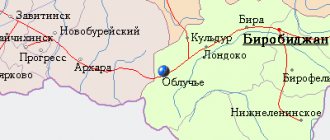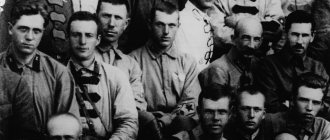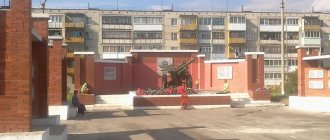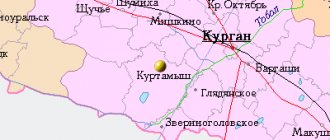This term has other meanings, see Makarov.
| City Makarov A country
| |||||||||||||||||||||||||||||||
| Makarov Moscow |
| Yuzhno-Sakhalinsk Makarov |
Audio, photo and video
on Wikimedia Commons
K: Settlements founded in 1892
Makarov
- a city in Russia, the administrative center of the Makarovsky urban district of the Sakhalin region.
Population - 6753[1] people. (2016).
Story
According to some sources, the settlement was founded in 1892 as the village of Selutora
, which means “village on land” in Ainu.
Just two years later - in 1894 - there were already three houses in the village with a total number of inhabitants of 5 people - three men and two women, who, according to the category of residents, were considered exiled settlers. Their main occupations were agriculture, animal husbandry, fishing, and hunting. This information is taken from the document “Statement of the farms of exiled settlers of the Korsakov district who were on government pay,” stored in the Central State Archive of the Far East (Tomsk).
In 1890-1900 A postal route ran through the territory of the district from the Korsakovsky post to the Aleksandrovsky post. The Ainu transported mail to Nayoro (Gastello), where they exchanged it for mail that came from the north. At the same time, the village and postal and telegraph station “Mokun-Katane” (the Ainu name of the current village of Pugachevo) were founded.
In 1905, as a result of defeat in the Russian-Japanese War of 1904-1905, the southern part of the island ceded to Japan. The Japanese built a pulp and paper mill, a mine and other enterprises in Selutor. The village became a city, its Japanese name is Shiritoru.
From 1905 to 1945, together with the southern part of Sakhalin, it was part of Japan, called Shirutoru
or
Shiritoru
(Japanese: 知取).
After the end of World War II in 1945, it became part of Russia. In 1946 it was renamed Makarov
in honor of the Russian naval commander and oceanographer Admiral Stepan Makarov.
During Soviet times, a paper mill and a mine operated successfully in the city.
Russian Bath Kholmsk
Traces of the presence of ancient man on the territory of the modern Makarovsky region date back to the Stone Age - finds of stone tools and remains of ancient ceramics at the Pugachevsky sites and the river. Markovka (Paleolithic era).
One of the very first settlements of “modern” man in the region arose on the site of the Makunkotan camp (the village of Pugachevo). Here already by the eighties of the XIX century. There were two Japanese and one Russian fishing grounds, and there were convenient lands for arable farming. Then the Ainu began to choose places for more northern settlements. This is how the village of Venkotan appeared, next to which in an unflooded zone there was a small camp of Selutora (Makarov), which translated from Ainu meant “dry village” (“selyu” - dry, “tora” - a village in which at least three families in different yurts at the same time).
In 1890-1900 A postal route ran through the territory of the district from the Korsakovsky post to the Aleksandrovsky post. They transported mail to Nayoro (Gastello village, Poronaisky district), where they exchanged it for mail that came from the north. Near the Selutora camp in 1892, on the site of a temporary hut where postal sledges were changed, a telegraph machine appeared. Major Stender was appointed head of the work on the Selyutor machine tool. To help him, four soldiers, one sailor and three exiled settlers were assigned. The Central State Archive of the Far East (Vladivostok) preserves the “Report on the farms of exiled settlers of the Korsakov District who were on government pay,” which lists two names of three exiled settlers - Vasily Kotik and Dmitry Suvorov.
By the end of 1892, thanks to Stender’s complaints that the groups sent to build telegraph supports and improve the machine itself were constantly distracted by their superiors for any other work, they sent a whole detachment of exiled convicts, who became permanent residents here.
So 1892, when the construction of the telegraph machine began, and some small group of people began to live permanently in Selutor, can be considered the year of the founding of the city of Makarov.
In 1905, as a result of Russia's defeat in the Russo-Japanese War of 1904-05. The southern part of Sakhalin went to Japan. The period of the most intensive use of the area’s natural resources begins, among which forest and fish were in the first place, the construction of settlements (more than forty), and the agricultural, industrial and cultural development of the area. In Shiritori (as the Japanese called Selutora), the Japanese built a paper mill, mines, a pier, a sulfite-alcohol plant, a printing house, a water supply system, two agricultural farms (Porechye, Travyanaya), two cinemas and two theaters, a Shinto and other temples, a middle-level industrial school , where they trained specialists for the paper industry, and other enterprises. A railway was built through Siritori from the town of Otiaya (Dolinsk) to the town of Sikuki (Poronaisk).
In 1945, the ancestral Russian lands were returned to Russia. Japanese residents were repatriated to their homeland, their property was nationalized. To develop and boost the national economy, from May 15, 1946, a large flow of immigrants poured into Sakhalin, including the Makarovsky region. Mass renaming of settlements began. The new names were based on the names of the fighters for the establishment of Soviet power on Sakhalin - Art. Tsapko (in honor of the chairman of the Sakhalin Revolutionary Committee A.T. Tsapko, tortured by the Japanese), heroes of Russian history - p. Pugachevo (in memory of the leader of the Peasant War of 1773-1775, Don Cossack E.I. Pugachev). Other names were given simply according to the geographical location of the settlement (Vostochny, Gornoye, Zaozernoye, Porechye, Lesnoye, Elovoe, Verkhovye, etc.) or according to its climatic conditions (Tumanovo station).
By decree of the Presidium of the Supreme Council of the RSFSR on June 5, 1946, the city of Siritori was renamed the city of Makarov in memory of Admiral S.O. Makarov. The name of Stepan Osipovich Makarov appeared on the map of Sakhalin not by chance.
According to the documents stored in the regional archive, it is clear that in 1896-98. S.O Makarov was in Sakhalin on the cruiser “Kornilov”. During these years, he was engaged in laying a beam from Vladivostok to the Korsakovsky post. Entry from 1896 states that S.O. Makarov visited the governor’s house, visited the Japanese consul, visited the prison, came on “fishing trips” and was interested in the life of the settlers. The name of the city is not only a memory of the admiral who died during the Russo-Japanese War, but also as an assessment of his human and business qualities.
On June 5, 1946, 14 districts were formed on the territory of the South Sakhalin region, including Makarovsky with its center in the city of Makarov. The territory of the Makarovsky district is 2148.4 square meters. km., is located on the eastern coast of the southern part of Sakhalin Island and is washed by the waters of Terpeniya Bay in the Sea of Okhotsk. In the south, the region borders with the Dolinsky district, in the west - along the tops of the West Sakhalin ridge - with the Uglegorsky and Tomarinsky districts, in the north - with the Poronaisky district.
From September 1945 to March 1947, state power in the region was exercised by the district department for civil affairs, headed by chief A.A. Zolin. The civil affairs departments of the city of Makarov, the villages of Vostochny, Gorny and Ugledarsk were subordinate to the district administration. In 1947, on the territory of the Makarovsky district, the working village of Vostochny and rural Soviets were formed: Gorny (Gorny village, Markovo station, Tumanovo station), Pugachevsky (Pugachevo village, Poyasok station, Tikhaya station, Tsapko station, Art. Travyanaya), Ugledarsky (village Ugledarsk) and Novsky (village Novoe). The Porechensky Village Council appeared only in 1963. It included settlements - the village. Poreche, village Lazo, Art. Grebenskaya, st. Zaozernaya and Ugledarsk village.
In December 1947, the first elections to local councils were held in the region, the Makarovsky district and city councils were elected. The councils and their executive committees solved the priority tasks of economic and social development. Housing was built to receive immigrants from the mainland, schools, a hospital, and cultural institutions were opened, the work of local industrial enterprises was established (the Sovetsky Sakhalin food production plant, five fishing collective farms, a fish processing plant (Makarov) and a fish factory (Vostochny village)). Stable labor collectives were being formed at a paper mill, three mines, and a timber industry enterprise. In 1949, the Makarovsky state farm was organized.
Housing construction was underway in the area. By the end of the 40s, 800 log houses of the Russian type were built. In 1950, there were 27 schools, 18 medical institutions, 9 clubs, 33 libraries and reading rooms in the area.
In the 60-80s, work continued on the further development of the economy and social sphere. Intensive housing construction was underway, dilapidated Japanese barracks, heated by iron stoves, gradually disappeared. In their place, stone multi-storey comfortable housing grew. The city was transforming.
Industrial enterprises operated steadily: a pulp and paper plant, a food processing plant, a meat and dairy plant, a bakery plant, and the Makarovsky state farm. The main city-forming enterprises were Makarovsky pulp and paper.
In the 90s, the economy of the Makarovsky region underwent enormous changes. As a result of the worsening economic situation in the country, financial problems, and the protracted energy crisis, almost all industrial enterprises in the region found themselves on the verge of bankruptcy. Unable to withstand competition in the new economic conditions, in 1999 the Makarovsky Pulp and Paper Plant was closed for conservation. Due to unprofitability, the Makarovskaya mine was liquidated in April 2000.
As of January 1, 2010, 8.8 thousand people lived in the district, including 6.7 thousand people in the city of Makarov. The municipal formation "Makarovsky urban district" includes the city of Makarov and 10 villages: the village. Vostochnoe, s. Tsapko, s. Pugachevo, s. Quiet, s. Poreche, village Grebenskoye, village Zaozernoye, village Gornoe, village Tumanovo, s. New.
Currently, the main sectors of the region's economy are: fishing, food (production of canned fish, fresh-frozen fish and seafood, bread, bakery and confectionery products), mining of non-metallic building materials, and agriculture. In the area there are 000 "Rybak", 000 "Victoria", 000 "Turovka" (Novoe village), CJSC "Pugachevsky Fish Hatchery" (pugachevo village), LLC "RPP "Makarovskoe", LLC "Avtomobilist", LLC "Universal" -, MUP "Stroitel", Makarovsky branch (DSZ) of LLC "Trud-Sakhalin" (Village of Zaozernoe), State Unitary Enterprise "DRSU Makarovskoye" (Village of Porechye) and other enterprises.
The network of medical institutions consists of one district hospital, four paramedic and obstetric stations, a city clinic, and an emergency medical service station.
In the area there are two kindergartens, 6 schools, a children's art school, a children's and youth sports school, an evening (shift) school, a youth sports club, a branch of the Yuzhno-Sakhalinsk Industrial and Economic College and the Yuzhno-Sakhalinsk branch of the modern humanitarian academy.
The network of cultural and educational institutions is represented by the Center for Art, Culture and Leisure (which includes a district house of culture, a local history museum and three rural clubs) and the municipal institution “Makarovsk Centralized Library System” (which consists of a central, children's libraries and 4 rural libraries - branches). Since 1993, there have been two churches in Makarov - Orthodox and Presbyterian.
In recent years, many residents have left this corner of Sakhalin land, but they certainly return here in thought or reality. They return for the cold rains, June fogs, rare red berries, fish and caviar... They also return because they cannot erase from their memory the smell of the sea and the sound of the surf, grass as tall as a man and chamomile meadows, that unique beauty of nature that attracts forever .
Makarov residents expressed their love for their hometown, the memory of its past and hopes for its future in a memorial stele made from a monolith from the Ugledar deposit and installed on the station square of the city for its 100th anniversary. The inscription on the stele reads: “1892-1992. Selutora-Siritori-Makarov. Eternal memory to those who lived, love and kindness to those who live.”
Climate
The city of Makarov is equated to the regions of the Far North.
- Average annual air temperature - 2.5 °C
- Relative air humidity - 70.0%
- Average wind speed - 6.3 m/s
| Climate of Makarov | |||||||||||||
| Index | Jan. | Feb. | March | Apr. | May | June | July | Aug. | Sep. | Oct. | Nov. | Dec. | Year |
| Absolute maximum | −0,6 | 3,3 | 7,8 | 15,4 | 22,8 | 27,4 | 27,5 | 29,9 | 25,1 | 20,6 | 12,9 | 2,4 | 29,9 |
| Average maximum, °C | −10 | −8,1 | −2,3 | 6,0 | 13,2 | 19,4 | 22,8 | 22,5 | 17,4 | 9,6 | −0,4 | −7,8 | 7,0 |
| Average temperature, °C | −13,8 | −12,4 | −7 | 1,5 | 8,2 | 13,9 | 17,3 | 17,5 | 12,8 | 5,7 | −3,5 | −11,1 | 2,5 |
| Average minimum, °C | −17,9 | −17,1 | −12,2 | −2,9 | 3,2 | 8,9 | 12,5 | 13,2 | 8,8 | 2,2 | −6,6 | −14,5 | −1,8 |
| Absolute minimum, °C | −27,4 | −27,4 | −22,9 | −12,9 | −3,4 | 0,2 | 4,1 | 6,5 | 0,4 | −10,7 | −17,2 | −24,3 | −27,4 |
| Source: [sakhalin-meteo.ru/makarov/pivot/temperature Meteorological statistics for the Sakhalin region] [data.oceaninfo.info/atlas/Oxot/2_airtemp_station_94013_1.html ESIMO] | |||||||||||||
Makarov
(Sakhalin region)
OKATO code:
64224501
Founded:
1892
City since:
1946 City of regional subordination
Center:
Makarovsky district
The city was formerly called:
| Selutora | 1905 | |
| Siritoru | 1905 | 1946 |
| Telephone code (reference phone) | |
| 42443***** | — |
| 424434**** | — |
Deviation from Moscow time, hours:
8
Geographic latitude:
48°37′
Geographic longitude:
142°47′
Altitude above sea level, meters:
20 Sunrise and sunset times in the city of Makarov
Notes
- ↑ 123
www.gks.ru/free_doc/doc_2016/bul_dr/mun_obr2016.rar Population of the Russian Federation by municipalities as of January 1, 2021 - Administration of the governorate of Karafuto.
20-100 thousand people. Korsakov • Kholmsk • Okha 10-20 thousand people. Poronaysk • Dolinsk • Nevelsk • Aleksandrovsk-Sakhalinsky • Uglegorsk • Nogliki 3-10 thousand people Aniva • Shakhtersk • Tymovskoye •
Smirnykh
•
Makarov • Yuzhno-Kurilsk
•
Troitskoye
• Tomari •
Gornozavodsk
•
Bykov
•
Sokol
•
Chekhov
•
KrasnogorskStory Treaties (Simodsky 1855 • St. Petersburg 1875 • Portsmouth 1905 • Peking 1925) • Russo-Japanese War (Actions on Sakhalin) • Karafuto • Occupation of Northern Sakhalin • Soviet-Japanese War (Operations: Yuzhno-Sakhalinsk • Kuril • Landings: Maoka • Otomari • Thoreau) • Repatriation of the Japanese • Sakhalinlag • Construction 506 • Earthquakes and tsunamis (North Kurilsk 1952 • Neftegorsk 1995 • Nevelsk 2007) • Typhoon 1981 Symbols Coat of Arms • Anthem • Flag Geography Volcanoes • Mountain peaks • Mountain ranges • Nature reserves and sanctuaries • Climate • Lakes • Islands (Sakhalin • Kuril Islands) • Plains • Rivers Power Governor • Government • Regional Duma • Regional Court • Regional Arbitration Court • Charter • Twin Cities Administrative division Sakhalin department (1884-1909) • Sakhalin region (1909-1920) • Sakhalin district (1925-1932) • South Sakhalin region (1945-1947) • Coats of arms • Flags • Regional diocese • Apostolic prefecture Education Schools • Universities Healthcare Health care institutions Population Ainu • Koreans • Nivkhs Economy Enterprises and companies (pulp and coal plant • Mines) • Tourism • Offshore projects Transport Bus systems (Yuzhno-Sakhalinsk • Kholmsk) • Highways (P487 • A391 • P490 • A392) • Airports • Railway (Stations and platforms) • Seaports Connection Internet • Television • Radio stations • Mail • Media Culture Attractions • Museums • Theaters Sport Athletic facilities Portal "Sakhalin Region" •
Project "Sakhalin Region": Incorrect or missing image To improve this article it is desirable: - Find and arrange in the form of footnotes links to independent authoritative sources that confirm what is written. K: Wikipedia: Articles without sources (type: not specified)
An excerpt characterizing Makarov (city)
- Kuragin! back,” Dolokhov shouted. - Treason! Back! Dolokhov, at the gate where he stopped, was struggling with the janitor, who was trying to lock the gate behind Anatoly as he entered. Dolokhov, with his last effort, pushed the janitor away and, grabbing the hand of Anatoly as he ran out, pulled him out the gate and ran with him back to the troika. Marya Dmitrievna, finding a tearful Sonya in the corridor, forced her to confess everything. Having intercepted Natasha’s note and read it, Marya Dmitrievna, with the note in her hand, went up to Natasha. “Bastard, shameless,” she told her. - I don’t want to hear anything! - Pushing away Natasha, who was looking at her with surprised but dry eyes, she locked it and ordered the janitor to let through the gate those people who would come that evening, but not to let them out, and ordered the footman to bring these people to her, sat down in the living room, waiting kidnappers. When Gavrilo came to report to Marya Dmitrievna that the people who had come had run away, she stood up with a frown and folded her hands back, walked around the rooms for a long time, thinking about what she should do. At 12 o'clock at night, feeling the key in her pocket, she went to Natasha's room. Sonya sat in the corridor, sobbing. - Marya Dmitrievna, let me see her for God’s sake! - she said. Marya Dmitrievna, without answering her, unlocked the door and entered. “Disgusting, nasty... In my house... Vile little girl... I just feel sorry for my father!” thought Marya Dmitrievna, trying to quench her anger. “No matter how difficult it is, I’ll tell everyone to be silent and hide it from the count.” Marya Dmitrievna entered the room with decisive steps. Natasha lay on the sofa, covering her head with her hands, and did not move. She lay in the same position in which Marya Dmitrievna had left her. - Good, very good! - said Marya Dmitrievna. - In my house, lovers can make dates! There's no point in pretending. You listen when I talk to you. – Marya Dmitrievna touched her hand. - You listen when I talk. You have disgraced yourself like a very lowly girl. I would do that to you, but I feel sorry for your father. I'll hide it. – Natasha did not change her position, but only her whole body began to jump up from silent, convulsive sobs that choked her. Marya Dmitrievna looked back at Sonya and sat down on the sofa next to Natasha. - He’s lucky that he left me; “Yes, I will find him,” she said in her rough voice; – Do you hear what I’m saying? “She put her big hand under Natasha’s face and turned her towards her. Both Marya Dmitrievna and Sonya were surprised to see Natasha’s face. Her eyes were shiny and dry, her lips were pursed, her cheeks were drooping. “Leave... those... that I... I... will die...” she said, with an angry effort she tore herself away from Marya Dmitrievna and lay down in her previous position. “Natalya!...” said Marya Dmitrievna. - I wish you well. You lie down, just lie there, I won’t touch you, and listen... I won’t tell you how guilty you are. You know it yourself. Well, now your father is coming tomorrow, what will I tell him? A? Again Natasha's body shook with sobs. - Well, he will find out, well, your brother, groom! “I don’t have a fiance, I refused,” Natasha shouted. “It doesn’t matter,” continued Marya Dmitrievna. - Well, they’ll find out, so why leave it like that? After all, he, your father, I know him, after all, if he challenges him to a duel, will it be good? A? - Oh, leave me alone, why did you interfere with everything! For what? For what? who asked you? - Natasha shouted, sitting up on the sofa and looking angrily at Marya Dmitrievna. - What did you want? - Marya Dmitrievna cried out again, getting excited, - why did they lock you up? Well, who stopped him from going to the house? Why should they take you away like some kind of gypsy?... Well, if he had taken you away, what do you think, he wouldn’t have been found? Your father, or brother, or fiancé. And he’s a scoundrel, a scoundrel, that’s what! “He’s better than all of you,” Natasha cried, standing up. - If you hadn’t interfered... Oh, my God, what is this, what is this! Sonya, why? Go away!... - And she began to sob with such despair with which people only mourn such grief, which they feel themselves to be the cause of. Marya Dmitrievna began to speak again; but Natasha shouted: “Go away, go away, you all hate me, you despise me.” – And again she threw herself on the sofa. Marya Dmitrievna continued for some time to admonish Natasha and convince her that all this must be hidden from the count, that no one would find out anything if only Natasha took it upon herself to forget everything and not show to anyone that anything had happened. Natasha didn't answer. She didn’t cry anymore, but she began to feel chills and trembling. Marya Dmitrievna put a pillow on her, covered her with two blankets and brought her some lime blossom herself, but Natasha did not respond to her. “Well, let him sleep,” said Marya Dmitrievna, leaving the room, thinking that she was sleeping. But Natasha was not sleeping and, with fixed, open eyes, looked straight ahead from her pale face. All that night Natasha did not sleep, and did not cry, and did not speak to Sonya, who got up and approached her several times. The next day, for breakfast, as Count Ilya Andreich had promised, he arrived from the Moscow region. He was very cheerful: the deal with the buyer was going well and nothing was keeping him now in Moscow and in separation from the countess, whom he missed. Marya Dmitrievna met him and told him that Natasha had become very unwell yesterday, that they had sent for a doctor, but that she was better now. Natasha did not leave her room that morning. With pursed, cracked lips, dry, fixed eyes, she sat by the window and restlessly peered at those passing along the street and hurriedly looked back at those entering the room. She was obviously waiting for news about him, waiting for him to come or write to her.








